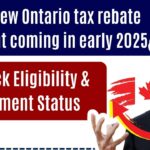
Are You Getting the $800 Stimulus Check in December: As the year draws to a close, many Americans are asking, “Are we getting an $800 stimulus check this December?” With so much buzz around stimulus payments, it’s essential to sort fact from fiction and understand the current situation. Whether you’re hoping for financial relief or simply want clarity on the matter, this guide will break down everything you need to know in a simple and straightforward way.
Are You Getting the $800 Stimulus Check in December?
| Topic | Details |
|---|---|
| Stimulus Check Amount | Up to $800 (rumored, no official confirmation for federal level in December 2024) |
| Confirmed Programs | Some state-level programs, such as South Carolina’s tax rebates and Arizona’s Family Tax Rebate, have concluded. |
| Eligibility | Dependent on individual state programs or past federal stimulus criteria (e.g., income thresholds, tax filings). |
| Official Source | Visit IRS Economic Impact Payments or your state’s tax department for updates. |
While the idea of an $800 stimulus check in December 2024 may sound appealing, it’s crucial to rely on accurate information. As of now, no federal payment has been announced, though state-level programs and community resources may offer relief in specific areas. To stay informed, always check official resources like the IRS or your state’s tax department. Remember, financial preparedness, exploring available resources, and creating a robust plan can help you navigate uncertain times effectively.
What’s Happening With the $800 Stimulus Check?
The idea of an $800 stimulus check has been circulating online, but here’s the truth: there is currently no federal stimulus check of $800 approved for December 2024. All federal Economic Impact Payments, issued in response to the COVID-19 pandemic, were completed by the IRS in 2021. These payments helped millions of Americans, but no new payments are on the horizon at the federal level.
State-Level Initiatives
While the federal government hasn’t announced new stimulus payments, some states have implemented their own relief programs to help residents. Let’s take a closer look:
1. South Carolina’s Tax Rebates
South Carolina offered tax rebates of up to $800 to eligible residents based on their 2021 tax returns. This program has concluded, and no new payments are planned. For more details, visit the South Carolina Department of Revenue.
2. Arizona Families Tax Rebate
In Arizona, qualifying families with dependents received rebates of up to $750. This initiative aimed to support families affected by inflation. Like South Carolina, this program is no longer active. Check updates at Arizona Department of Revenue.
3. Other State Programs
Some states, such as California and Colorado, have historically issued their own stimulus-like payments. If you’re unsure about your state’s programs, check with your state’s tax authority.
4. Local Community Relief Initiatives
In addition to state programs, some local governments and community organizations offer relief to residents in need. Programs such as utility bill assistance, rental aid, and food subsidies can help bridge financial gaps. Visit your local government’s website or nonprofit organizations in your area for more details.
Why No Federal Stimulus This Time?
Unlike the pandemic period, where massive federal aid was necessary to stabilize the economy, the U.S. economy has shown signs of recovery in 2024. Unemployment rates are near historic lows, and inflation, while still a concern, has cooled compared to previous years.
Understanding Economic Factors
Stimulus checks are typically issued during times of economic crisis. In 2020 and 2021, for example:
- Unemployment rates soared above 14%, prompting urgent relief measures.
- Millions of households faced income loss, necessitating financial support.
Today, the economic landscape has shifted. While not everyone is financially secure, there is less justification for broad federal stimulus payments.
Targeted Relief as an Alternative
Instead of broad stimulus checks, governments may opt for targeted relief measures. For example, expanded Medicaid coverage, child care subsidies, or food assistance programs focus on helping specific groups who are most in need.
How to Prepare For $800 Stimulus Check in December
Even though an $800 stimulus check isn’t on the horizon, there are steps you can take to improve your financial situation. Here are some practical tips:
1. Review State Benefits
- Check if your state offers ongoing benefits or rebates.
- Visit Benefits.gov for a comprehensive list of state and federal programs.
2. Maximize Tax Credits
Tax season is around the corner, so make sure you claim all eligible credits, such as:
- Earned Income Tax Credit (EITC): Designed for low- to moderate-income workers.
- Child Tax Credit (CTC): Provides significant relief for families with dependents.
- Education Tax Credits: If you or a dependent are enrolled in school, explore options like the American Opportunity Tax Credit (AOTC).
3. Emergency Savings
If possible, set aside money for emergencies. Experts recommend saving at least 3-6 months’ worth of living expenses, but even small contributions add up over time.
4. Debt Management
Take this time to evaluate your debts and create a repayment strategy. Consider consolidating high-interest debts or negotiating lower rates with creditors to ease your financial burden.
5. Look for Supplemental Income Opportunities
Explore part-time work, freelancing, or selling unused items online to generate additional income. Websites like Upwork and Etsy can help you monetize your skills and creativity.
USA 2025 Minimum Wage Increase: These 3 States Will Raise Pay Levels, Check Details
USA Medicaid Program 2024 – Who Is Eligible, Amount & How To Claim?
FAQs about Are You Getting the $800 Stimulus Check in December?
Q: Is the $800 stimulus check real?
A: Currently, there is no federal $800 stimulus check approved for December 2024. Some states have had their own programs, but these are separate from federal efforts.
Q: Who was eligible for past stimulus checks?
A: Past stimulus checks were typically based on income thresholds. For example, individuals earning up to $75,000 annually ($150,000 for couples) qualified for full payments during the pandemic.
Q: How can I check if I’m owed money?
A: Visit the IRS website’s Get My Payment tool to check your payment history. Additionally, contact your state tax office to explore local benefits.
Q: Are there other forms of financial assistance available?
A: Yes. Programs like the Supplemental Nutrition Assistance Program (SNAP), housing assistance, and healthcare subsidies can provide support. Visit Benefits.gov for more information.
Q: What can I do if I’m struggling financially?
A: In addition to seeking government assistance, consider reaching out to community organizations, such as United Way, for financial counseling and resources. Nonprofits like Feeding America can also help with food security.








